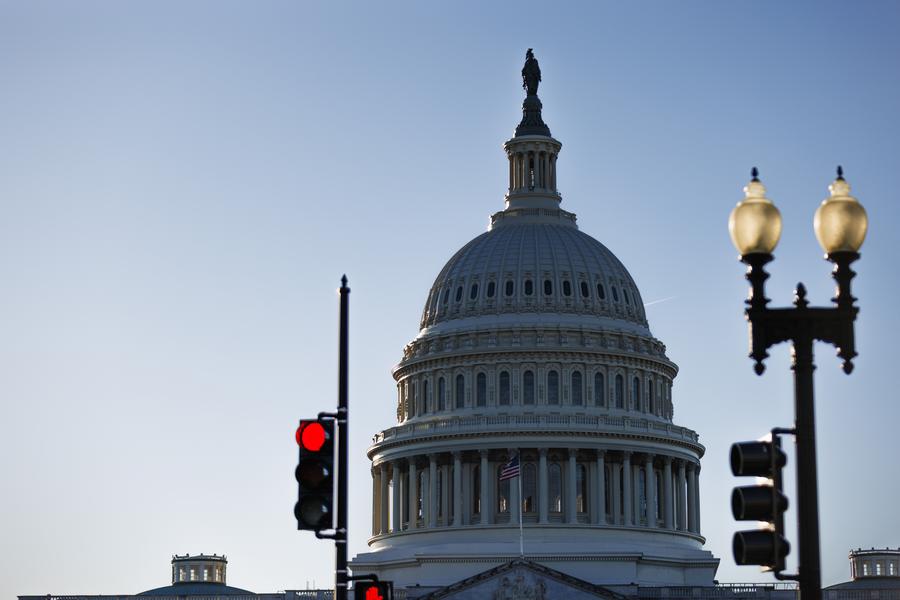
The U.S. federal government's total public debt has surpassed 35 trillion U.S. dollars for the first time, equivalent to the combined economic output of China, Germany, Japan, India and Britain.
by Xiong Maoling, Yu Rong
WASHINGTON, July 31 (Xinhua) -- The U.S. federal government's debt has surpassed yet another psychological threshold amid widespread concerns.
According to data released by the U.S. Treasury Department on Monday, the federal government's total public debt has surpassed 35 trillion U.S. dollars for the first time, as recorded at the end of last week, equivalent to the combined economic output of China, Germany, Japan, India and Britain.
Why is the U.S. national debt growing at an accelerated pace? Why can't calls from all sectors awaken a political conscience to address the issue? Has the scale of the debt reached a critical crisis point?
Upon reviewing the historical trajectory of U.S. debt, it has become clear that the country has developed an addiction to borrowing, depending on the dollar's dominant position in the global economy. The debt scale has surged on an unsustainable path, driven by a failing political system and ineffective governance, causing ongoing harm both domestically and globally.
SURGING DEBT LEADS TO RISING INTEREST PAYMENTS
Data shows that 40 years ago, the U.S. federal government debt was less than 1 trillion dollars. However, it has grown rapidly in recent years, surpassing 20 trillion dollars in September 2017 and exceeding 30 trillion dollars in February 2022.
The U.S. debt-to-GDP ratio surpassed 100 percent in 2013 and currently stands at 123.3 percent, according to the International Monetary Fund (IMF).
"We've officially added another trillion dollars to the gross national debt. If this sounds familiar, we only just reached 34 trillion dollars at the very end of 2023. We passed 33 trillion three months before that and 32 trillion three months before that. The borrowing just keeps marching along, reckless and unyielding," Maya MacGuineas, president of the Committee for a Responsible Federal Budget, said in a statement.
The rapid increase in U.S. national debt has directly led to a corresponding rise in future interest payments. Data shows that interest payments on national debt are expected to become the fastest-growing component of the federal budget over the next 30 years.
"We're not investing enough in our future. But we are spending more than 2 billion dollars per day on interest payments on the debt," said the Peter G. Peterson Foundation, a nonpartisan organization focused on addressing U.S. long-term fiscal challenges.
According to projections by the Congressional Budget Office released in June, interest costs are projected to increase from 9 percent of federal revenue in 2021 to 18 percent in 2024 and 23 percent in 2034. Interest costs would also become the largest "program" over the next few decades -- even surpassing Social Security.
"Action is needed by the United States to reduce its high fiscal deficit and to put debt on a downward trajectory. I should say that we have been highlighting these concerns for quite some time," IMF spokesperson Julie Kozack said at a recent press briefing.
"Looking even further ahead, our estimate is that net interest payments are expected to remain elevated even in the medium term. And that is on the basis of high primary fiscal deficits and the resulting public debt," Kozack said in response to a question from Xinhua. "We are calling for an action to be taken to reduce the U.S. deficit and debt at this time."
WHO IS RESPONSIBLE?
Debt is among the most clear-cut and consequential problems in the U.S. economic and financial sectors. JPMorgan Chase CEO Jamie Dimon has even called U.S. public debt the "most predictable crisis" facing the American economy. Given this, why does the debt continue to spiral out of control?
"How we got here is a long story of repeated chapters of fiscal irresponsibility on both sides of the aisle. Leaders in Washington have made imprudent decisions over decades, time and again choosing a favorite new tax cut or spending program above our collective future," said Michael A. Peterson, CEO of the Peter G. Peterson Foundation, when the U.S. national debt surpassed 30 trillion dollars.
According to the foundation, the national debt of 35 trillion dollars translates to 103,945 dollars of debt per person in the United States. "It's not only unsustainable, it's a moral failure that will harm our children and grandchildren," Peterson said, urging policymakers to put the nation on a strong and sustainable fiscal path.
Desmond Lachman, a senior fellow at the American Enterprise Institute and a former official at the IMF, told Xinhua earlier that while Republicans prefer tax cuts without cutting public spending, Democrats favor increasing public spending without raising taxes.
Lachman said the net result is that the country continues to run budget deficits, with public debt on an unsustainable path.
Experts and observers have indicated that lawmakers in Washington have shown minimal interest in reducing spending or implementing meaningful budget reform. With the 2024 presidential election less than 100 days away, national debt is not a major topic of discussion.
"The leading presidential candidates, Vice President Kamala Harris and former President Donald J. Trump, have said little about the nation's deficits on the campaign trail, suggesting that the economic problem will only worsen in the coming years," The New York Times reported.
"There is zero support for cuts in any major areas," Dean Baker, a senior economist at the Center for Economic and Policy Research, told Xinhua.
"The deficit projections are evidence of a broken budget system," Barry Bosworth, economist and senior fellow at the Brookings Institution, said.
"SERIOUS QUESTIONS FOR THE DOLLAR"
At its core, the United States takes on new debt to pay off the old, and this is largely due to the dollar's dominance, some have argued. They believe the United States has leveraged the dollar's supremacy to shift its risks and extract global wealth through interest rate fluctuations.
However, its long-term addiction to borrowing has led to an inability to curb its profligate habits, thus planting the seeds of a debt crisis. In the long run, it could come back to haunt the country.
As the U.S. national debt approaches 35 trillion dollars, JPMorgan analysts have warned investors in a new memo about the risks associated with rising budget deficits and high sovereign debt levels. They advised investors not to expect any significant improvement in the U.S. fiscal outlook in the near term.
"The problem will be caused by the market and then you will be forced to deal with it, and probably in a far more uncomfortable way than if you dealt with it to start," Dimon said earlier this year.
"I think America should be quite aware that we have got to focus on our fiscal deficit issues a little bit more, and that is important for the world," Dimon added.
Bosworth also argued that while it is not an immediate crisis, it will become more constraining in future years. "The growing public debt will slowly crowd out private investment and increase foreign finance and control of the domestic economy," he said.
Lachman, meanwhile, said that the "dangerous trajectory" poses "serious questions for the dollar" and inflation's long-run outlook. Foreigners may be unwilling to finance the U.S. government if they perceive no real willingness to bring the country's public finances under control.
"That could lead to a dollar crisis, and it could also require the Federal Reserve to print money to finance the government," Lachman said. "That would be a sure recipe for a renewed surge in inflation." (Matthew Rusling also contributed to the article) ■










